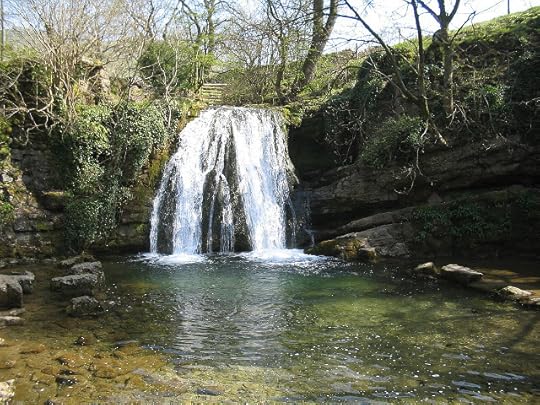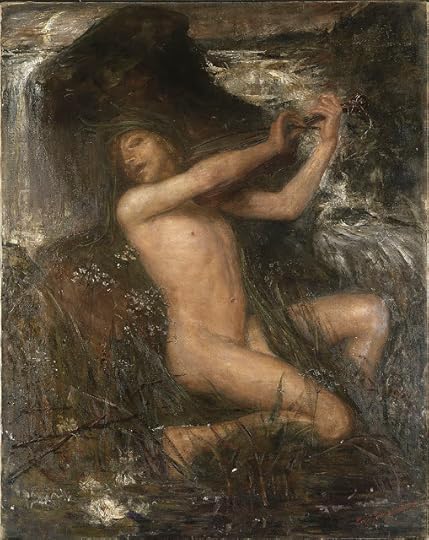Searching for Janet, Queen of the Fairies
This essay first appeared in issue 19 of Gramarye, Winter 2019

The little village of Malham in the Yorkshire Dales is set in a landscape of stunning natural beauty close to the great curved cliff of Malham Cove and the dramatic gorge of Gordale Scar. Romantic painters flocked to it. Turner painted the Cove (see above), and the engraver William Westall published a set of views of the area that inspired Wordworth to write sonnets on the Cove and the Scar, though he never personally set eyes on either of them. ‘Pensive votary!’ he exclaimed in 1818,
… let thy feet repair
To Gordale chasm, terrific as the lair
Where the young lions couch; for so, by leave
Of the propitious hour, thou mayst perceive
The local deity, with oozy hair
And mineral crown, beside his jagged urn
Recumbent: him thou mayst behold, who hides
His lineaments by day, yet there presides,
Teaching the docile waters how to turn…
These efforts earned the dry comment from the author of an 1850 guide to the area: ‘Had they been written on the spot, instead of suggested by the engravings of Westall, they might have been of interest.’ Romantic visions of the kind Wordsworth encouraged may well have shaped a local legend, however, as we shall see.
You can walk to the Scar along the road from the village, but it’s prettier to take the path by the side of Gordale Beck. (A goreor geir is an ancient name for an angular or triangular piece of land: an appropriate term for the ever-narrowing valley into the gorge.) The streamside path runs through sloping pastures into a wooded limestone ravine called Little Gordale. In springtime it’s full of the starry white flowers of wild garlic, the beck rushing ever down over stones at your right hand. Before you reach Gordale Scar itself, at about the half-way point in fact, the winding up-and-down path brings you to the brink of a deep pool at the foot of a small and beautiful waterfall – Janet’s Foss. On the far side of the pool is a shallow cave tucked under a ledge of rock which can be reached by crossing the natural stepping stones that dam the pool. If you’re feeling adventurous though, and the water isn’t roaring down too hard, you can clamber up the rock-face to the right of the waterfall and wriggle your way into a much smaller cave that’s actually hidden behind the fall itself. It’s pretty damp. Never mind: it is the home of Janet, the local fairy queen.

Everyone in Malham knows this, but though I lived in the village for years and my parents lived there for decades I was never able to find out any more about Janet the fairy queen. No-one local knew any stories about her. And I began to wonder… well, is she a genuine piece of folklore? Or was she invented relatively recently, as a tourist attraction perhaps? My starting point was a brief paragraph in Arthur Raistrick’s classic book about the dale: Malham and Malham Moor (1947):
Foss is the old Norse name for a waterfall, and Janet was believed to be the queen of the local fairies … The fall is not high, but is remarkable for the beautiful tufa
It’s striking that this late Victorian writer turns what is really a set of walking instructions (‘take the right-hand stile opposite the row of thorn-bushes’) into something far more picturesque. Gray wants to remind us that a rowan is a ‘witch-tree’; he brings in classical nymphs and fauns; ‘airy little’ fairies dance in the silver moonlight of the ‘witching hour’ – before the prosaic conclusion:
Emerging from this cool and shady recess the visitor descends a field path to a small gate, whence the return to Malham may be made l. by the high-road; or r.to Gordale Scar.
Flowery as it is, this account shows that a tradition of a fairy queen named Janet was already associated with the spot by 1895 although her name was attached to the cave rather than to the ‘foss’ or waterfall itself.
Ten years earlier however, a party from the Blackburn Teacher’s Association visiting Malham for a day out in June 1885, received a rather different account of Janet. They lunched at the Buck Hotel, walked to the Cove and Gordale Scar where they viewed the waterfall, and then visited:
‘Janet’s Cave, where the legend runs that the witch Janet and her followers used to assemble at the cave’
In 1839 Robert Story of Gargrave, a village about eight miles from Malham, published a remarkable play in Shakespearian blank verse. He dedicated it to ‘Miss Currer of Eshton Hall’. She was an accomplished woman who collected historical manuscripts and rare printed works, and Eshton Hall was one of the most important houses around, situated in parkland a mile outside Gargrave on the Malham road.
Story, born in Northumberland in 1795 and whose father was a farmhand, worked as a shepherd and gardener before discovering a love of poetry. He moved to Gargrave in 1820, where he gained a reputation as ‘the Craven poet’. His play – unlikely ever to have been performed – is The Outlaw
The scheming Norton disguises himself as Henry disguised as a monk – impersonating him in order to frame him, if you follow me – and sets up an ambush for Lady Margaret at Gordale Scar where she has come to view the chasm: here Robert Story lets himself go with some vivid Romantic scene painting:
All gaze in silence
NORTON
Your silence moves no wonder. Gordale hath,
In its first burst of unexpected grandeur
A spell to awe the soul and chain the tongue.
How great its Maker then!
LADY MARGARET
… it might seem a tower
Whose architects were giants, did yon stream
Mar not the fancy.
RODDAM
Or a cavern hewn
From out the solid rock by genii!
LADY EMMA
Or fairy palace, by enchantment raised
To hold the elfin court in!
LADY MARGARET
‘Tis a scene
Too stern and gloomy for those gentle beings,
That love the green dell and the moonlight ring.
I like my first impression.
Like Lady Margaret, people visiting the Lakes or the Dales – not yet an easy journey in the early 1800s – were determined to get their money’s worth out of the experience. Writing at the more hard-headed end of the century, Johnnie Gray points out that some early accounts almost double the true heights of certain hills, representing Whernside and Pen-y-ghent as mountains well over 5000 feet high, for instance. This tendency to exaggerate and romanticize local attractions means we cannot assume, when the lovelorn Fanny talks about the Fairy Queen Gennet, that her words are based on genuine folklore.
This is the Fairy’s cave. Hast seen her, Norton?
But she ne’er shows herself, except to eyes
That soon must close in death.
Similar stories were told at Walton-le-Dale, at Warrington, and at Fairfield near Buxton in Derbyshire as well as Manchester, where in about 1800 a stream called ‘Shooter’s Brook’ passed in a culvert under the aqueduct which carried the Manchester and Ashton-under-Lyme canal over Store Street, near the London Road Station (now Manchester Piccadilly):
At that period there existed an opening or break left in the culvert forming a dangerous spot for children to play beside, and yet they often selected it. Their mothers tried to destroy the fascination by stating that Jenny Greenteeth laid in wait at the bottom to ‘nab’ children playing there.

And was Jenny Greenteeth once more than a nursery tale? Responding to John Higson’s piece in ‘Notes and Queries’, a correspondent named James Bowker claimed that ‘the water spirits of the Gothic mythology, although in other respects endowed with marvellous and seductive beauty, had green teeth…’ He provides no reference, but Jacob Grimm, in his ‘Teutonic Mythology’ (1835) says that the Danish water spirit, the nøkke, wears a green hat and that ‘when he grins you see his green teeth’
Picture Credits:Malham Cove by Turner, Tate BritainJanet's Foss, Gordale, CC BY-SA 3.0, https://commons.wikimedia.org/w/index... Fairy's Lake by Jon Anster Fitzgerald 1866, TateGordale Scar, James Ward, 1811, Tate Britain, part of a collection entitled "Gordale Scar (A View of Gordale, in the Manor of East Malham in Craven, Yorkshire, the Property of Lord Ribblesdale)" Nøkken, Theodor Kittelsen, 1904, National Musem of NorwayNäcken (Water Spirit) by Ernst Josephsen, National Museum of SwedenGordale Scar, James Ward, Tate Britain.



